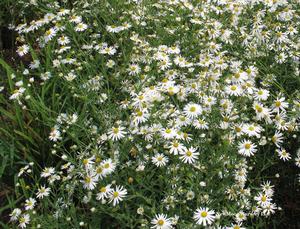New Moon Nurseries
Boltonia asteroides
Thousand-flowered aster
Native to North America
FIRST IMPRESSIONS: Boltonia asteroides is an upright rhizomatous perennial. Foliage is long and narrow with an attractive blue-green color. In late summer, a galaxy of starry white daisies adorn the plant. The individual blossoms are similar to those of asters or fleabane. Plant thrive in sunny wetlands or in average garden soils.
HABITAT & HARDINESS: Plants occur in eastern and central North America. The range extends from Canada to North Dakota, east to Maine and south to Florida and Texas.
Boltonia asteroides is indigenous to bottomland forests, thickets, wet meadows and prairies, marshes, stream or pond banks and ditches.
Hardiness rating is from USDA Zones 3-9.
PLANT DESCRIPTION: Boltonia asteroides produces many sturdy stems from vigorous underground rhizomes. The stems begin to branch when they are about half their mature height.
Leaves are gray green and linear or oblong in shape. They make a fine backdrop when an abundance of glistening white flower heads appear in late summer. Each daisy-like flower is almost 1” wide consisting of about 60 slender white petal-like ray florets surrounding a dense cluster of numerous yellow disc flowers.
Plants are quite striking when the “thousands” of blossoms materialize in late summer and autumn. From a distance, the billowy white clouds of flowers look like a bodacious clump of baby’s breath. The floral display is unique because most other plants flowering at this time are yellow or purple. Plants attain a stately 3-5’ height with an equal spread.
CULTURAL & MAINTENANCE NEEDS: In full sun Boltonia asteroides usually has strong vertical stems.
In shaded gardens stems may need to be staked to discourage flopping. Plants can also be pruned back by a third in late spring to encourage shorter more sturdy growth.
Boltonia asteroides grows in average garden soil or in moist or wet sites. Plants tolerate seasonal flooding, clay soils and periods of drought.
This perennial expands from underground rhizomes and needs periodic dividing in garden situations.
Plants may have issues with powdery mildew if planted in shade. Otherwise, they are pest resistant and somewhat unpalatable to deer and rabbits.
LANDSCAPE USES: This is a good choice for a Pollinator Garden or Wet Meadow. Plants are also used as Butterfly Nectar Plants or on the back row of a Perennial Border. Boltonia asteroides has Showy Blooms and can be used in Cottage Gardens, Deer Resistant Plantings, Low Maintenance Plantings, Roadsides and Wetlands.
COMPANION & UNDERSTUDY PLANTS: Try pairing with Asclepias incarnata, Aster puniceus, Chelone glabra, Eupatorium maculatum, Eupatorium perfoliatum, Helenium autumnale or Carex vulpinoidea.
Aster umbellatus has a similar floral display and cultural needs and can be substituted if needed.
TRIVIA: Boltonia asteroides is a member of the Aster Family but is not a true aster.
Boltonia spp. differ from true asters because their small one seeded fruits (achenes) are scaly with a pair of bristles. Aster spp. have achenes with tufts of hair. Seed of Aster spp. are usually dispersed by wind or attached to animal fur. Seed of Boltonia spp. either fall a short distance from the parent plant or are dispersed by water.
Flowers attract beneficial bees, wasps, flies, butterflies, skippers, moths, and beetles.
Height:
3-5 ftSpread:
2-4 ftSpacing:
4-6 ftUSDA Hardiness Zone:
3-9Bloom Color:
WhiteBoltonia asteroides Characteristics
Attracts Wildlife
- Butterflies
- Pollinators
Attributes
- Rain Garden
- East-Coast Native
- Dried Flower
- Cut Flower
- Clay Soil
- Bog
- Naturalizing
- Long Blooming
Exposure
- Full Sun to Partial Shade
Deer Resistant
- Deer Resistant
Flowering Months
- September
- August
- July
Foliage Color
- Green
Growth Rate
- Fast
Season of Interest (Foliage)
- Summer
- Spring
Soil Moisture Preference
- Wet to Moist
Interesting Notes:
For more information on this plant, visit the USDA PLANTS Database:http://plants.usda.gov/java/profile?symbol=BOAS
